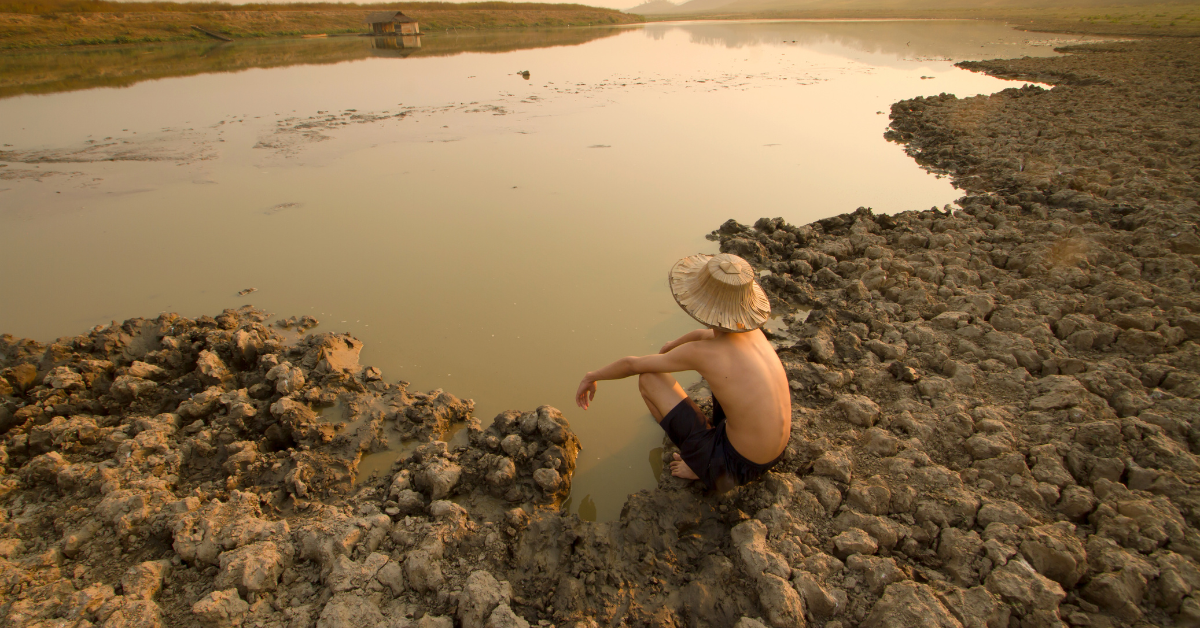
Climate Refugees
In response to the climate crisis, Paragon Law and Nottingham Trent University are co-funding a PhD into climate change and refugee law.

Emma Robinson
Climate Change and Refugee Law
In 2022 a collaboration between Nottingham Law School and Paragon Law will see a PhD student investigate the relationship between climate change and refugee law. With the impacts of climate change ever increasing, this PhD has never been as relevant. To further understand the need of this study Director of Studies, Dr Helen O’Nions, produced the following article.
The link between migration and climate change
Climate change, along with the human displacement and the forced migration it creates, has increasingly demanded global attention in recent years. Since 2008, it is estimated that an average of 22.5 million people a year have been displaced by extreme weather events alone. Countless more are displaced due to the slower onslaught of drought, salinization - making soil infertile for crop production, and rising sea levels. In 2018, the United Nations Refugee Agency recognized that ‘climate, environmental degradation and natural disasters increasingly interact with the drivers of refugee movements.’ More recently, both the UN Inter Governmental Panel on Climate Change (UN-IPCC) and the World Meteorological Organization (WMO) have reported on the increasing propensity for climate change-induced, extreme weather events. These reports also project that developing and less-developed countries will be hardest hit by such extreme weather events. Although recent heatwave and flood disasters in North America and Europe highlight that no region is safe from the vagaries of the climate change crisis, developing countries are less well-equipped to withstand the immediate and devastating impacts of such extreme weather events.
This has prompted Mami Mizutori, Special Representative of the Secretary-General for Disaster Risk Reduction and Head of UN Office for Disaster Risk Reduction (UNDRR) to note that:
‘More lives are being saved thanks to early warning systems, but it is also true that the number of people exposed to disaster risk is increasing due to population growth in hazard-exposed areas and the growing intensity and frequency of weather events. More international cooperation is needed to tackle the chronic problem of huge numbers of people being displaced each year by floods, storms, and drought. We need greater investment in comprehensive disaster risk management ensuring that climate change adaptation is integrated in national and local disaster risk reduction strategies.’
Thus, external migration is only one response to the challenges of climate change. There are schemes that reduce the need for migration, such as crop insurance schemes, and schemes that lead to or promote internal migration where those most impacted move from high to lower risk areas. However, these strategies will not be sufficient to address the needs of all those affected in the longer term.
The solution
The way that the subject is conceptualised dictates the way it is perceived and the effectiveness of regulatory responses. It must be acknowledged that the double sensitivity of both climate change and forced migration presents a particular challenge for conceptualisation. Any proposed international action that recognises and seeks to facilitate climate induced migration either within, or across national borders is likely to prove unpopular, with considerable costs and security implications. Of course, these costs are likely to increase if the problem is ignored but past experience suggests that states will not act unilaterally to uplift protection. Those most impacted by climate change do not have a strong voice to advocate or embarrass governments to act, leaving multi-layered regional or international mechanisms as the only way forward.
At the present time the obligations that may be owed to those who leave their homes because of climate change do not fall neatly within international environmental law initiatives, such as the Framework Convention on Climate Change, or international humanitarian obligations deriving from the 1951 Refugee Convention. Neither does the emerging discipline of ‘International Disaster Relief Law’ appear to offer much more than temporary respite to vulnerable and/or displaced communities.
Durable solutions must respect the fundamental rights and agency of those impacted and thus external migration is a legitimate response, which may be viewed as one of a number of adaptation strategies. In reality those most affected are unlikely to be in a position to externally migrate, but neither should they be expected to remain trapped in regions where they face insecurity, ill-health and poverty. This PhD provides an opportunity to identify how best to conceptualise climate induced migration but there are several observations which should inform this approach and some immediate questions that come to mind when considering the most appropriate response:
-
Should the response be local, regional or international (or a combination).
-
Should the response be grounded in humanitarian, environmental or human rights law
-
Does it require a free-standing treaty?
-
What role should the sustainable development goals play?
-
Are there existing/emerging approaches that can be used as best practice?
The place of refugee law
The internationally accepted definition of a ‘Refugee’ in Art 1A Refugee Convention 1951 does not easily apply to those fleeing the consequences of climate change. Whilst it may be argued that climate change could result in serious harm equivalent to persecution, it would be difficult to argue that persecution is for a reason listed in the Convention (race, religion, political opinion, nationality or particular social group). Further, the Convention requires that individuals demonstrate that they have been individually, uniquely impacted by ill-treatment. This has made it difficult for those fleeing generalized violence to make a case for refugee status. It may also be reasonably argued that there is little substantive difference between the position of climate change migrants and those fleeing extreme poverty or economic disadvantage (often labelled clumsily as ‘economic migrants’). Indeed, it may be difficult to identify climate change as the precise cause of migration, which is more likely to arise from a combination of intersecting factors. To date the only region that has seen obvious climate related external migration are the South Pacific islands where sea levels are rising at a rate of
12 millimetres each year. It has been estimated that by 2100, 48 islands will have been submerged and their inhabitants externally displaced.
The Refugee Convention itself is under considerable pressure with several states openly undermining the obligation of non-refoulement and seeking ways to deflect their responsibilities by seeking to process applications offshore. The European Commission’s response to the Syrian refugee ‘crisis’ in 2015-16, in which a third country (Turkey) was paid to host the majority of Syrians arriving in Europe, suggests there is little appetite for enhanced protection. In the UK the controversial Nationality and Borders bill is about to enter committee stage in the House of Commons. If enacted, it will radically change how refugees are processed in the UK with those who enter unlawfully receiving temporary, reviewable protection which will deny them vital family reunion rights. These proposals were modelled on the approach taken in Denmark. Recently the Danish authorities were internationally criticised for reviewing the temporary refugee status of Syrian nationals and returning a group of 100 Syrians to Damascus. In January the Danish prime minister Mette Frederiksen indicated to Parliament that Denmark intended to have no asylum applications in the future.
The conceptualisation of climate migration as an issue of refugee protection will not assist those who take action to move before things become desperate or those who stay behind because they lack the resources and opportunities to move. Perhaps most importantly, there is a genuine concern that the ‘refugee’ label is inherently problematic as it emphasises passivity, victimhood, and vulnerability. McNamara has accused the United Nations of portraying “environmental refugees” as helpless victims of climate change in urgent need of foreign assistance. This is of course a useful UN High Commissioner for Refugees (UNHCR) tool as it generates public sympathy which increases donations, thereby enabling action. However, as President Anote Tong of Kiribati remarked in 2009 it puts the “stigma on the victims, not the offenders.”
The conceptualisation of climate migration as an issue of refugee protection will not assist those who take action to move before things become desperate or those who stay behind because they lack the resources and opportunities to move. Perhaps most importantly, there is a genuine concern that the ‘refugee’ label is inherently problematic as it emphasises passivity, victimhood, and vulnerability. McNamara has accused the United Nations of portraying “environmental refugees” as helpless victims of climate change in urgent need of foreign assistance. This is of course a useful UN High Commissioner for Refugees (UNHCR) tool as it generates public sympathy which increases donations, thereby enabling action. However, as President Anote Tong of Kiribati remarked in 2009 it puts the “stigma on the victims, not the offenders.”
The role of environmental law
An alternative approach would be to ground climate change migration in obligations arising from international environmental law. Whilst the UN Framework Convention on Climate Change was not overly concerned with migration, the Paris Conference of Parties (COP) 21 created a Taskforce on Displacement mandated to develop recommendations for integrated approaches to avert, minimize and address displacement related to the adverse effects of climate change. Significantly this includes states, technical experts from different groups under the UNFCCC, UN agencies and representatives from civil society. The approach remains cautious but there may be an opportunity to build on this. The European Commission recently proposed reform to the Aarhus Convention on Access to Information, Public Participation in Decision-Making and Access to Justice in Environmental Matters 1998 to enhance access to justice and remedies for those impacted by climate change-induced extreme weather events?
The environmental law lens sees climate migration as part of an adaptive/resilience strategy, as stressed in the Cancun Adaptation Framework 2010. The advantages to this approach are that it returns agency to the migrant; enables a move away from vulnerability/protection versus security tropes; recognises that most migration is internal or regional; avoids a top-down approach and enables a multi-faceted response. It is understood that most of those impacted by climate change will be displaced within their countries or regions of origin, adding to global inequality and instability. Thus, international environmental policy discussions have tended to focus on resilience and capacity building in regions of origin.
However, there are considerable difficulties with this approach and there is perhaps a superficiality that demands scrutiny. The approach is difficult from an advocacy perspective, and it places responsibility on poorer nations and the most vulnerable to adapt. Not everyone is an agent of adaptation; many of the poorest will be forcibly displaced with little choice and women and children in particular may find their opportunity to adapt is illusory. In this sense adaptation seems more like endurance. It may also be suggested that the expectation of adaptation and resilience ignores the realities of temporary migration. For example, migrant workers are very often victims of exploitation and the opportunity to regularise their status is routinely denied.
The UN Sustainable Development Goals (10.7) led to the Global Compact for Safe, Orderly and Regular Migration which prioritises adaptation and resilience but specifically recognises that both relocation and visa options should be part of this package. Objective 2 is about minimizing the adverse drivers that compel people to move and includes a standalone section dedicated to climate change and disasters. In that respect, the text recognizes that climate change adaptation and resilience measures in countries of origin need to be prioritized to minimize the adverse drivers of migration.
Going forward
One way forward might be for an enhanced adaptation approach grounded in human rights norms and the obligation of non-refoulement in refugee law. There are decisions from the European Court of Human Rights (ECtHR) that could support such a direction, using rights including the right to life (Article 2), the prohibition of inhuman and degrading treatment (Article 3) and the right to a home life (Article 8). Articles 6 and 7 of the International Covenant on Civil and Political Rights could also be applied. As presently applied these rights tend to be argued against a particular government that has failed to protect the community (e.g. Oneryildiz v Turkey or Budayeva v Russia) or at the point of removal; they do not give a free-standing right to externally migrate to seek protection. States control entry through their borders and the ECtHR has never explicitly recognised a right of entry. Further, it is difficult to argue against a return to poverty or general insecurity unless there are very exceptional cases (as in the case of D v UK 1997 where the individual was suffering from the advanced stages of the Aids virus and was to be removed to St Kitts where there was no suitable healthcare available).
Yet these are ‘living’ instruments capable of evolving to respond to new challenges. The UN Human Rights Committee has stated that right to life should encompass a life with dignity in their recent opinion in Teitiota v New Zealand [2020]. The Teitiota family fled Tarawa in Kiribati claiming refugee status in New Zealand because of the impact of rising sea levels resulting in saltwater contamination and overcrowding. Whilst the family lost their case against deportation because they could not demonstrate a risk of persecution or imminent threat to life on return, the New Zealand Immigration and Protection tribunal did not exclude the possibility that environmental degradation could “create pathways into the Refugee Convention or protected person jurisdiction.”
The UN Human Rights Committee observed:
“Due to the impact of climate change and associated sea level rise on the habitability of Kiribati and on the security situation on the islands, he faced a real risk of impairment to his right to life under article 6 of the Covenant as a result of the State party’s decision to remove him to Kiribati”.
Finally, it is necessary to consider the important work of the Nansen initiative which attempts to bridge the forced migration and environmental law approaches. The Agenda for the Protection of Cross-Border Displaced Persons in the Context of Disasters and Climate Change views resilience as the key factor in determining whether and how individuals, families, communities, and countries can withstand the impacts of sudden-onset and slow onset natural hazards and impacts of climate change. A variety of measures including disaster risk reduction activities, infrastructure improvements, urban planning, land reform, and other development measures are envisaged to strengthen the resiliency of vulnerable persons or groups. Significantly the Agenda views ‘migration with dignity’ (both temporary and permanent) as an important option for those whose living conditions have deteriorated. The Agenda received the support of 108 countries in 2015 and perhaps offers the greatest hope for multi-stakeholder consensus. The initiative does not seek to develop new legal standards or instruments but provides a strong foundation to build new soft law standards and binding agreements.
Our response
In light of all the above issues, Paragon Law and Nottingham Law School (NLS), Nottingham Trent University (NTU) have combined forces to support a PhD in the broad topic of Climate Change and Human Migration.
Applications for the PhD programme close on 1st November for a January 2022 start. The supervision team invite prospective applicants to contact them to discuss their ideas with a view to formulating a 2000-word proposal relating to any of the issues touched on above. We will also be hosting an interactive webinar on 6th October to discuss some of these themes.
To make an application, or for further information then head over here:
To get in contact with Dr Helen O’Nions then send an email over to [email protected].
Subscribe for updates

Climate Change and Refugee Law
Not ready to talk? Our free immigration resources may have the answer to your questions

Global Talent Visa: Eligibility, Requirements and Application Process

Border Security, Asylum and Immigration Act 2025 – What Employers Need to Know
.png)
UK Immigration Rule Changes 2025: Visa and Settlement Reforms Explained
%20What%20Sponsors%20Need%20to%20Know%20(1).png)
Upcoming Increase to the Immigration Skills Charge (ISC): What Sponsors Need to Know

Home Affairs Committee Launches Call for Evidence on Settlement Reforms

UK Immigration Rules 2025–2027: Key Visa & Policy Changes Explained

UK Immigration White Paper 2025: Visa & Settlement Rule Changes Explained

Home Secretary on UK Immigration: Settlement Rules & Border Control
.png)


